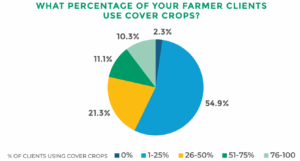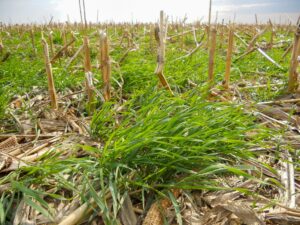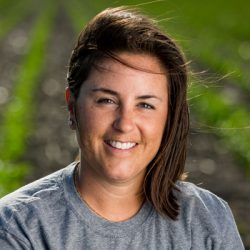
By: 4R Plus
August 2020
On the flat, tile-drained landscape, Webster County farmer Kellie Blair says their farm’s stewardship efforts are focused on minimizing nutrient losses from subsurface drainage. Alongside her husband, AJ, they rely on 4R Plus practices to help reach their goal for continual improvement by enhancing soil health and protecting Iowa’s natural resources.
As the fourth generation to farm the land, the Blairs incorporate a variety of “Plus” conservation practices along with the 4Rs of nutrient stewardship. “We learned when we focus on controlling runoff, we are also building organic matter and improving the quality of the soil,” she said. “The in-field practices – cover crops, no-till, strip-till and our data-driven nutrient management program – provide the control we need to protect our investment and the natural resources.”
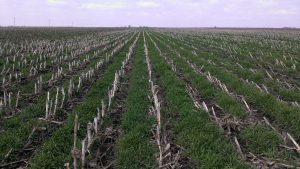
Tile outlets are tested annually and the initial results signaled change was needed. “The baseline nitrate count was one of the highest in the state,” Blair said, who is also a Certified Crop Adviser. “Thanks to the use of no-till and strip-till along with cover crops, now it’s lower than the standards for safe drinking water.
“Even though we’re relatively young farmers, we started experimenting with cover crops about 15 years ago,” she added. “It’s important that we benchmark where we start so we can measure progress through our farming career. I’ve always been interested in conservation and believe if I’m not protecting the soil then I’m not doing my job as a farmer, a mother and a community member.”
She recalls their first experience with cover crops. “We drove the four-wheeler into a field and seeded some areas by hand to see what it was all about,” she said.
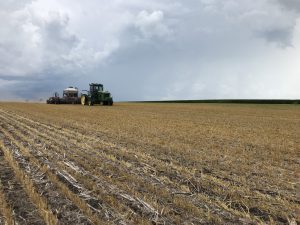
“We are still learning a lot about cover crops and primarily use rye on at least a third of the acres we farm. No matter when it’s seeded in the fall, it almost always comes back in the spring,” she added. “In addition to the soil health and water quality benefits, the greatest economic benefit of cover crops for us is a feed source for grazing cattle. The weed control in our seed beans is another great benefit.”
The Blairs recently diversified their farm by adding oats into their crop rotation. “We know through research that adding a longer rotation protects water quality and provides a benefit to our corn and soybean yields,” she said. “It also allows us to spread out some of the labor. We have fewer acres of corn and soybeans planted in the spring. That’s fewer acres to harvest in the fall. Spreading out the workload gives us more time to spend together as a family.”
The oats are harvested in early July. “After this year’s oat harvest we drilled a mix of cover crops to experiment with some different blends,” she said. “This also extends the time our cattle can graze on cover crops.”
During the winter, the Blairs are busy planning and analyzing data to make decisions for the upcoming growing season. “Between soil and water samples, yield data and manure analysis, we have a lot of data to analyze so we can make informed business decisions,” she said. “Since Mother Nature throws something different at us each year, we are focused on making the soil resilient. As farmers we need to be willing to change and learn.”

